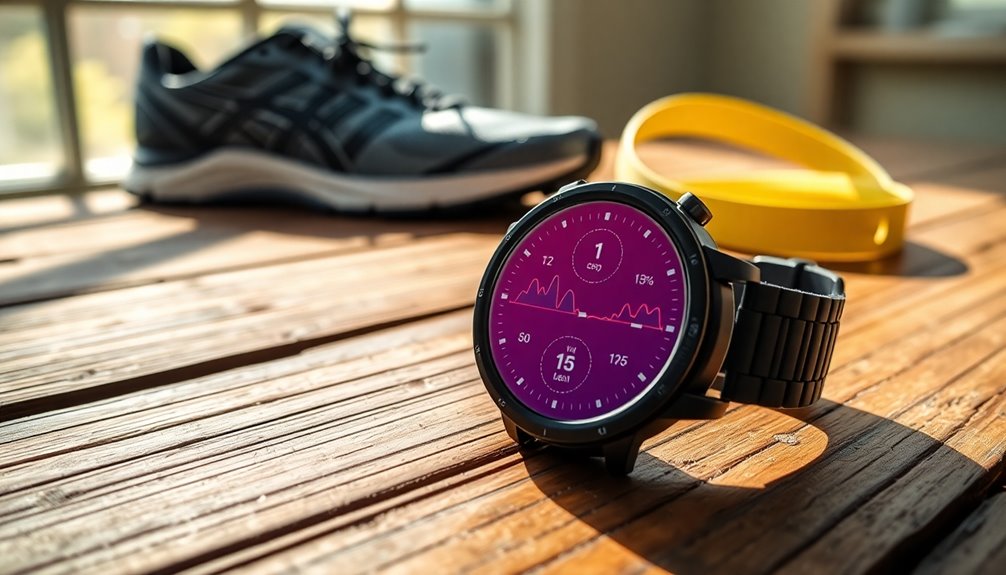Tracking your progress as a runner is essential for reaching your goals and staying motivated. Setting clear goals, breaking them into smaller milestones, and using tools like running apps and journals can help you monitor your workouts effectively. Focus on key metrics like distance, pace, and effort levels while balancing technology with personal insights. Celebrating achievements, both big and small, and engaging with the running community can boost your motivation. Discover more about maximizing your running journey and achieving success.
Key Takeaways
- Use running apps like Strava or Runkeeper for real-time tracking of distance, pace, and heart rate during workouts.
- Maintain a running journal to document your workouts, including distance, time, feelings, and personal bests for motivation.
- Incorporate a color-coded system to categorize workouts by effort levels and track daily mileage toward specific goals.
- Set mini-goals, such as completing a 10k, to maintain focus and celebrate achievements along your running journey.
- Regularly reflect on your experiences and comfort levels during runs to understand your physical limits and improve performance.
The Importance of Setting Clear Goals

Setting clear goals is essential for your success as a runner, especially when you want to track your progress effectively. When you set goals like completing a marathon or improving your 5K time, you create a clear path through your running journey.
Breaking larger targets into smaller milestones, such as running a 10K before tackling a half marathon, keeps you motivated and focused. Consistently tracking your personal bests not only motivates you but also highlights your improvements over time.
Establishing mini-goals, like gradually increasing your weekly mileage, helps prevent injuries and supports sustainable training. Reflecting on your achievements fosters a sense of accomplishment and encourages your ongoing commitment to future running objectives.
Effective Methods for Tracking Workouts
Tracking your workouts is just as important as setting your running goals. By keeping a running journal, you can document key details like distance, time, and your feelings during each run. This fosters self-awareness and improvement.
Using running apps like Strava or Runkeeper allows you to track your distance, pace, and heart rate in real time, making it easier to measure your progress. Regularly timing yourself on familiar routes helps you notice improvements in speed and endurance. Many of the best apps for runners also offer features such as personalized training plans and social sharing options, which can enhance motivation and accountability. Additionally, they often provide insights into your performance trends, allowing you to set and achieve specific fitness goals. By leveraging these tools, you can transform your running experience and make consistent strides toward better health and fitness.
Don't forget to log your personal bests; they're great motivators! You can also incorporate a color-coded system in your logs to reference your effort levels, which enhances your ability to identify patterns and make informed training decisions. Additionally, ensuring a balanced diet tailored to your running needs can significantly enhance your overall performance.
Key Metrics Every Runner Should Log
Logging key metrics can considerably enhance your running experience, as it provides valuable insights into your training. Start by recording the type of workout you complete—whether it's an easy run, speed work, or a long run. This helps diversify your training routine and assess its effectiveness.
Daily mileage is vital; by tracking total mileage, you can monitor your progress towards your goals. Don't forget to document your time and pace to evaluate speed improvements over time.
Additionally, jot down how you felt during each run and rate your perceived effort on a scale of 1 to 5. These subjective assessments can reveal patterns that inform your running data, ultimately leading to better performance and recovery. Incorporating mindfulness practices into your running routine can also enhance focus and enjoyment.
Utilizing Technology for Progress Monitoring
As you embrace technology in your running routine, you'll find that tools like GPS watches and running apps can dramatically enhance your ability to monitor progress.
These innovations help you track key metrics and stay motivated. Consider these features:
- Real-time distance and pace tracking with GPS
- Heart rate monitoring for optimizing workout intensity
- Customizable training plans to meet your goals
- Goal-setting features to keep you focused
- Analytics tools for evaluating long-term performance
Using a combination of these technologies, like apps and heart rate monitors, can provide personalized feedback.
This way, you can train smarter, identify areas for improvement, and hold yourself accountable in your journey toward fitness objectives.
Embrace these tools to elevate your running experience!
The Role of Community in Your Running Journey

Incorporating technology into your running routine can greatly enhance your experience, but the journey doesn't have to be a solo endeavor.
Joining running clubs can provide you with a supportive network of fellow runners who share your goals. This community allows you to celebrate achievements and compare performances, making every run more enjoyable.
Participating in community events like the Bowood House Triathlon or the Staffordshire Middle Distance Triathlon can challenge you while connecting you with others who understand your journey.
Staying engaged with this community helps you stay motivated, especially during tough times or the holiday season. Additionally, many running clubs organize group training sessions to help members improve their skills and stay accountable.
Analyzing Your Training Data for Improvement

When you analyze your training data, you reveal insights that can greatly enhance your running performance. By tracking metrics like pace, distance, and heart rate, you can identify patterns and make necessary adjustments.
Here are some key aspects to focus on:
- Review your training logs regularly to spot gaps in essential workouts.
- Use tools like Strava or TrainingPeaks for tracking personal bests.
- Analyze heart rate data to guarantee you're training in the right intensity zones.
- Set benchmarks and conduct fitness assessments every 4-6 weeks.
- Make informed adjustments based on your progress and data.
Maintaining Consistency in Your Training

To maintain consistency in your training, it's crucial to establish a routine that fits your lifestyle and goals.
Start by setting clear, specific, and measurable goals to guide your efforts and boost motivation. Using a running journal or fitness apps can help you document your runs, tracking distance, pace, and how you feel. This accountability encourages you to stick to your plan and increase your weekly mileage.
Regularly assess your fitness every four to six weeks with time trials or races, allowing you to monitor improvements and adjust your training as needed.
Engaging with the running community through clubs or events can also provide valuable social support, keeping you motivated and committed to your training consistency.
Understanding the Limitations of Tracking Tools
While tracking tools can provide a wealth of data, they can also lead to information overload that distracts you from what truly matters.
It's easy to focus on numbers and forget about your feelings during a run, which are crucial for understanding your progress.
Additionally, relying too much on technology can cause you to miss out on personal reflections that enhance your training experience.
Data Overload Risks
As you dive deeper into your running journey, the allure of tracking tools can sometimes lead to data overload, clouding your understanding of what truly matters.
To navigate these data overload risks, consider the following:
- Focus on key metrics that align with your goals.
- Regularly review your data for insightful patterns.
- Balance technology use with personal insights from your runs.
- Avoid getting lost in numbers at the expense of your well-being.
- Engage actively with your training logs for emotional satisfaction.
Subjective Experience Neglected
Although tracking tools offer a wealth of objective data, they often miss the mark when it comes to capturing your subjective running experience. GPS devices typically record metrics like distance and pace, but they overlook how you feel during your runs.
This oversight can lead you to neglect valuable insights about your emotional state, energy levels, and overall enjoyment. When you rely solely on technology, you might miss opportunities for reflective learning and improvement.
To gain a better understanding of your performance, consider keeping personal notes alongside your data. Reflecting on your feelings, challenges, and achievements will help you track not just the numbers but also the essence of your running journey, enriching your overall experience. Emphasizing achievements can also help build your self-worth and enhance your motivation over time.
Tech Dependency Concerns
Many runners find themselves increasingly reliant on technology to gauge their performance, often overlooking the inherent limitations of these tracking tools.
While apps offer valuable data, it's essential to recognize their constraints and the potential tech dependency concerns that arise.
Pay attention to these factors:
- GPS primarily measures distance and pace, missing personal feelings.
- Easy data uploads can lead to neglect of performance reflection.
- Lack of engagement with data obscures improvement patterns.
- Overreliance can hinder self-assessment of physical and mental states.
- Logging workouts without actionable insights creates a data gap.
Celebrating Non-Time-Based Achievements

Celebrating non-time-based achievements in running can be just as rewarding as hitting a new personal record. Consider tracking your comfort, endurance, and recovery. These metrics reveal significant progress that might not show up on a stopwatch.
| Achievement | Example |
|---|---|
| Increased Endurance | Running longer distances |
| Enhanced Recovery Times | Feeling refreshed post-run |
| Improved Mood | Noticing positive mental shifts |
| Consistent Weekly Mileage | Completing a set distance weekly |
Acknowledge milestones like overcoming personal challenges or maintaining consistency despite obstacles. These moments deepen your appreciation for the running journey, fueling your motivation. So, keep celebrating every step forward!
Staying Motivated Through Reflection and Adaptation

As you continue your running journey, reflecting on your experiences can be a powerful tool for staying motivated. Regularly jotting down your thoughts in a journal helps you identify effective training methods and areas for improvement.
Here are some strategies to keep you engaged:
- Set mini-goals, like running a 10k before a half marathon.
- Track non-time-based achievements, such as comfort levels or recovery times.
- Utilize heart rate zones to adjust your training intensity.
- Join a Run Club for shared motivation and support.
- Celebrate each milestone to boost your spirits.
Frequently Asked Questions
How Can I Track My Running Progress?
To track your running progress, start by keeping a running journal where you document your distance, time, and how you felt during each run.
Use GPS watches or running apps to monitor your pace and heart rate in real-time.
Set specific, measurable goals and break them into smaller milestones.
Regularly assess your personal bests on the same routes to see improvements, and reflect on your feelings during runs to gain insights into your training experience.
What Is the 80% Rule in Running?
The 80% rule in running means you should aim to complete 80% of your weekly mileage at an easy pace.
This approach helps you build endurance while reducing the risk of injury. By balancing hard workouts with recovery runs, you'll enable your body to adapt and improve over time.
Following this rule can enhance your aerobic capacity and overall performance, making your training sustainable and enjoyable, regardless of your experience level.
What Is the 5 4 3 2 1 Running Drill?
Imagine your heart racing like a drum as you tackle the 5 4 3 2 1 running drill.
You start with five minutes of steady running, letting your pace settle in.
Then, you shift to four minutes of brisk walking, catching your breath.
Next, you pick up speed for three minutes, jog for two, and finally, you release your inner sprinter for one exhilarating minute.
This method boosts your endurance and keeps your workouts fresh and exciting!
What Is the 3/2-1 Method Running?
The 3/2-1 method is a structured running approach that alternates between three minutes of running, two minutes of walking, and one minute of running.
You repeat this cycle for a set time, making it a great way to build your endurance gradually.
This method is particularly useful if you're a beginner or returning to running after a break, as it helps reduce injury risk while enhancing your overall fitness.
Conclusion
In your running journey, tracking your progress isn't just about hitting faster times; it's about celebrating each step you take. You might think it's overwhelming or complicated, but with the right tools and techniques, it can be straightforward and even enjoyable. Embrace the process, engage with your community, and remember that every run contributes to your growth. By reflecting on your achievements, you'll stay motivated and inspired to push your limits further. Keep moving forward!









